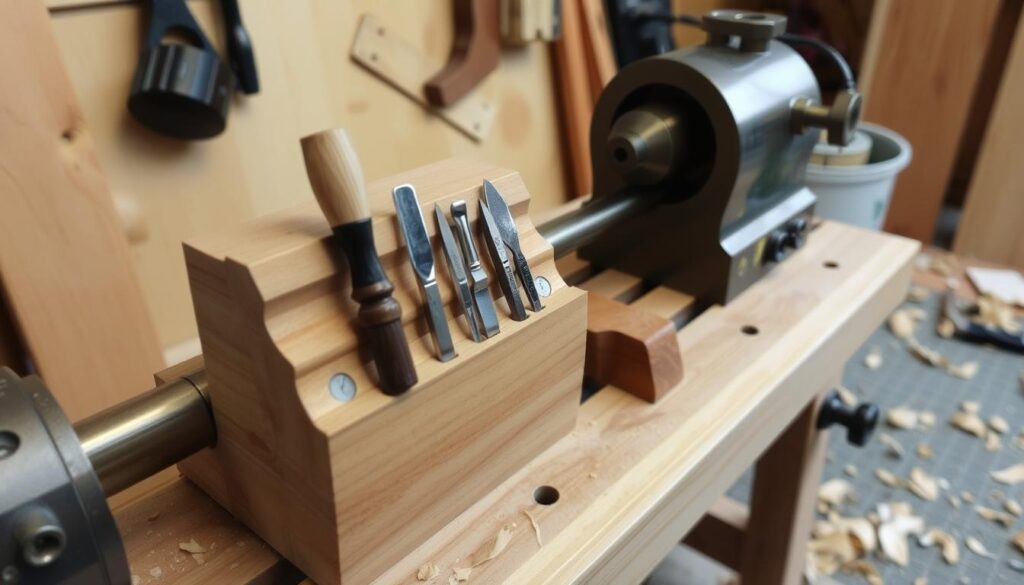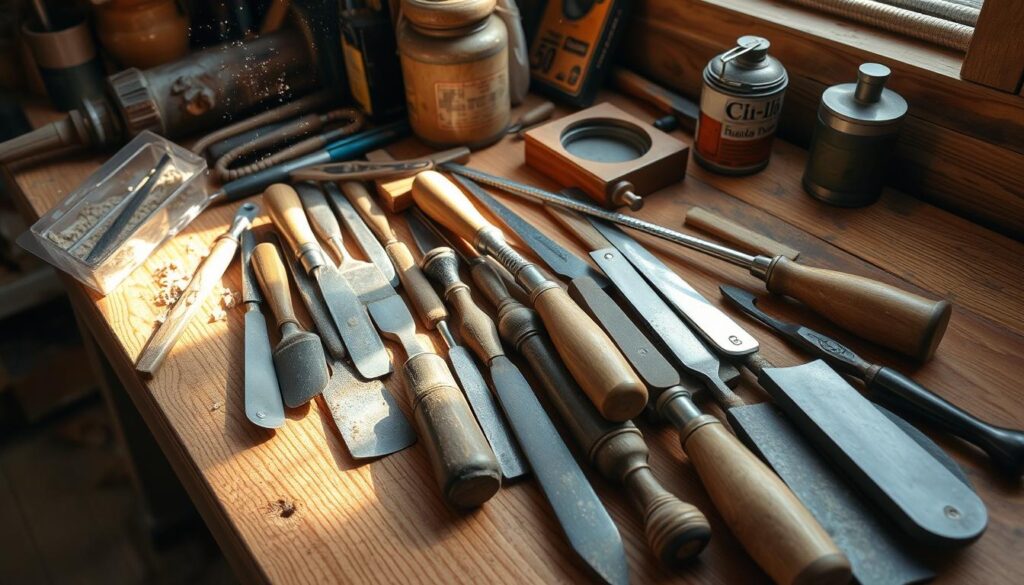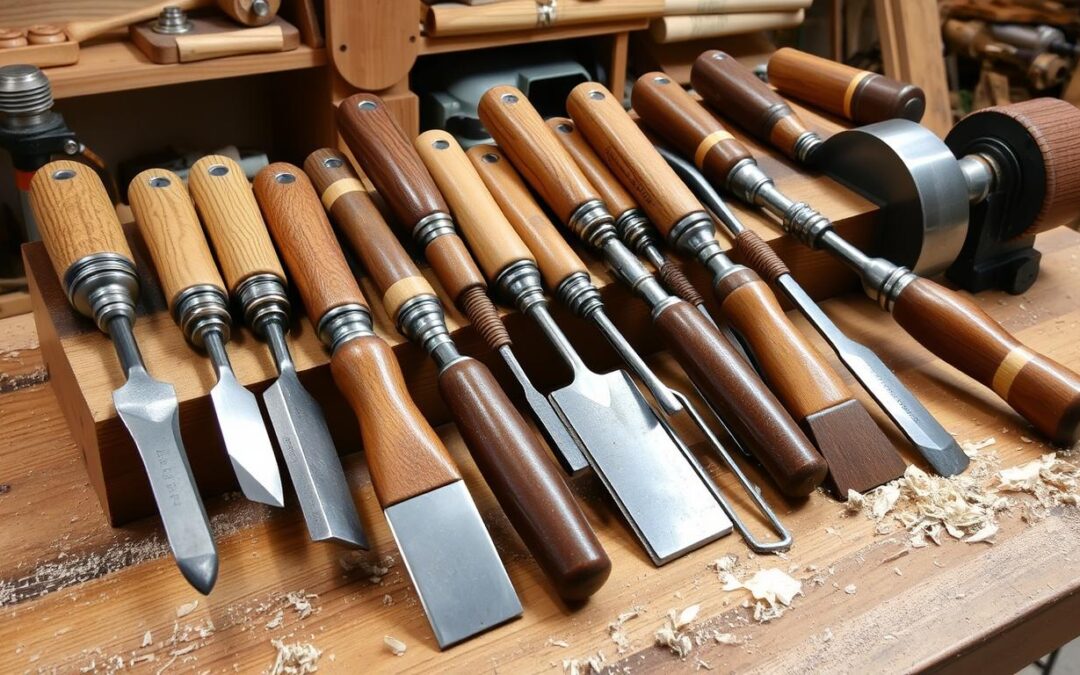The art of turning wood into beautiful shapes depends a lot on the wood lathe. For beginners, learning to use a wood lathe is a big step. It opens the door to the world of woodturning. On the other hand, professional turners always look for the best woodwork lathe tools to improve their skills.
Starting your woodturning journey means more than just picking a tool. It’s about understanding the precision and versatility these tools offer. Every woodturner knows that the quality of their lathe tools greatly affects their work. This guide will help you learn about the different types of lathe tools. You’ll find out what’s best for beginners and what advanced tools can do.
Key Takeaways
- Discover how the choice of a wood lathe and its tools can impact your woodworking projects.
- Understand which lathe tools are considered essential for both beginners and professional woodturners.
- Gain insights into what characteristics define the best woodwork lathe tools available on the market.
- Learn about the evolution of lathe tools over time and how it benefits modern-day woodturning.
- Prepare to delve into the maintenance practices that will ensure the longevity and efficiency of your lathe tools.
Understanding the Wood Lathe: An Introduction
Starting your woodworking journey means learning about the wood lathe machine. This guide will help you understand its history, types, and what to look for when choosing one. It’s all about improving your skills with woodworking tools for lathe.
History and Evolution of the Wood Lathe
The wood lathe has changed a lot over time. It started as a simple tool powered by hand. Now, it’s a high-tech machine with electric motors for better speed and precision.
Different Types of Wood Lathes Available
There are many wood lathes out there. You can find small ones for detailed work or big ones for heavy tasks. Each type helps turn woodworking into a unique art form, using special woodwork lathe tools list.
Factors to Consider When Selecting a Wood Lathe
- Size and Space: Make sure the lathe fits in your workspace well.
- Power and Speed: Think about what your projects need. More power for hard woods, variable speeds for different techniques.
- Features and Accessories: Look for lathes with adjustable tool rests or easy changes. These features help use a wide range of woodworking tools for lathe.
The Anatomy of Woodwork Lathe Tools
Knowing the parts of your wood turning lathe tools is key to improving your woodworking. Each part of the lathe tool set has a special role in shaping and finishing wood. This section will explain the different parts of these essential tools.
The main materials for lathe turning tools are high-speed steel (HSS), carbide, and sometimes carbon steel. The material affects the tool’s strength and how well it works on different woods. Let’s explore the anatomy of these tools:
- Handle: Made from wood or a strong composite, the handle helps with comfort and control.
- Ferrule: A metal ring or cap at the handle’s end that stops splitting and adds strength where the handle meets the blade.
- Blade: The part of the tool that does the work, with different shapes for various tasks like shaping, smoothing, or detailing.
- Bevel: The angled edge of the blade, important for controlling the cut when working with wood.
- Flute: The groove along the blade that helps remove wood shavings, ensuring clean cuts.
Now, let’s see how different parts of a lathe tool set help create unique profiles and textures on wood:
| Tool Part | Function | Use Case |
|---|---|---|
| Bevel | Guides the cutting angle | Creating smooth, rounded surfaces on bowls |
| Blade Shape | Determines the cut type | Detail work on spindles |
| Flute | Chip removal | Deep hollowing of vessels |
By understanding these parts, you can use your lathe turning tools better and improve your woodturning skills. Knowing when to use a sharp bevel angle or the right blade shape is crucial. Each part of your wood turning lathe tools plays a big role in the final product.
How to Choose the Best Woodwork Lathe Tools for Your Project
Starting a woodworking project means picking the right lathe tools woodworking is key. Knowing what to look for helps you choose wisely. This choice can make your project better and more enjoyable.
Think about the wood you’ll use. Different woods need different woodwork lathe tools set. Some woods are harder and need sharper, stronger tools.
- Project Complexity: More complex projects might need special tools from the lathe woodworking tools for sale.
- Skill Level: Your skill level should guide your tool choice. Beginners might start with simpler tools. Advanced users might choose more specialized ones.
- Tool Material: Tools made from high-carbon steel or carbide last longer and are more precise.
Choosing the right tools for your project is important. It ensures your work is precise and safe. It also makes woodworking more fun. By considering these factors, you can make the best choice for your needs and skill level.
Essential Woodwork Lathe Tools Set for Every Woodturner
Starting in woodturning means getting the right tools. They boost your skills, keep you safe, and make projects easier. We’ll look at key lathe tools like chisels, tool rests, and sharpening basics.
Chisels: Gouges, Skews, Parting Tools
Lathe chisels, including gouges, skews, and parting tools, are vital for shaping wood. Gouges are great for deep cuts in bowls and spindles. Skews are for smooth surfaces and details. Parting tools cut clean lines and separate wood from waste.
Lathe Tool Rest and Tool Holder Essentials
The lathe tool rest is crucial for support. It must be strong and adjustable for control and accuracy. The tool holder keeps chisels in place for safe, precise cuts. Quality tools make turning better.
Sharpening Systems for Lathe Tools
Sharpening lathe tools regularly is key to their performance. A dull tool is dangerous and slows you down. Get a good sharpening system for all chisel types. Sharp tools lead to better cuts and more fun turning.

- Lathe chisels for detailed and rough shaping
- Durable lathe tool rest for support and control
- Secure lathe tool holder for precise tool placement
- Efficient systems for lathe tool sharpening to keep tools in optimal condition
Having these basic lathe tools and sharpening them often will make your projects successful and fun. These tools are the base for all woodturning tasks, from detailed designs to sturdy pieces.
Woodworking Lathe Accessories to Enhance Your Turning Experience
Exploring woodturning reveals the importance of woodworking lathe accessories. They make your craft smoother, whether you’re new or experienced. Adding these tools lets you tackle more projects.
Lathe woodworking tools for sale include vital accessories. They range from safety gears to attachments for detailed work. Here are some key accessories for better woodturning:
- Tool Rests: Keeps your work stable and in control.
- Faceplates: Crucial for bowl turning, securing the wood to the lathe.
- Center Finders: Makes finding the wood’s center easy, ensuring accurate work.
- Calipers: Precise for measuring wood thickness, key for professional results.
Using top-notch woodworking lathe accessories can transform a basic lathe. It becomes a versatile tool for many tasks.
| Accessory | Function | Benefit |
|---|---|---|
| Chucks | Holds the wood securely | Increases the range of projects possible |
| Sanding Attachments | Allows for in-lathe sanding | Smoother finishes with less effort |
| Dust Collection Systems | Extracts dust and chips | Creates a cleaner and safer working environment |
| Lighting Systems | Enhances visibility | Improves accuracy and detail work |
Investing in these lathe woodworking tools for sale makes woodworking more fun and productive. These tools ensure each turn is precise and creative. They help you achieve more in your workshop.
Woodwork Lathe Tools Maintenance and Care
Keeping your woodwork lathe tools in top shape is key. Regular maintenance and care are essential. This guide will help you keep your tools running smoothly and know when it’s time for new ones.
Cleaning and Storing Your Woodwork Lathe Tools
Good care starts with cleaning and storing tools right. Clean them after each use to avoid build-up. Store them in a dry, organized spot to prevent rust and damage. Here are some tips:
- Wipe all surfaces with a dry cloth to remove debris.
- Apply a light coat of oil to metal parts to prevent rusting.
- Use wall-mounted racks or tool drawers lined with foam to organize and protect tools.
Sharpening Techniques for Peak Performance
Sharpening tools regularly is vital. Sharp tools make cuts cleaner and easier. Use a whetstone or bench grinder for the best results. Keep the angles right and check often for top performance.
Replacement Parts and When to Upgrade Your Tools
Maintenance isn’t just about cleaning and sharpening. It’s also about knowing when to replace parts or tools. Look for dullness, wear, or damage. Upgrading to better tools can greatly improve your projects.
| Tool Component | Signs of Wear | Recommended Action |
|---|---|---|
| Blades | Chips, cracks, or significant dullness | Replace blade or entire tool if repairs are not viable |
| Handles | Looseness, cracks, or splinters | Tighten or replace handle |
| Bearings and Joints | Sticking or excessive noise during operation | Apply lubricant or replace bearings |

Professional Tips for Using Lathe Woodworking Tools Effectively
Using professional woodwork lathe tools well is more than just handling them. It’s about knowing the right techniques, keeping tools in good shape, and working efficiently. Here are some woodworking lathe tips to help you get better and enjoy your work more.
- Plan Your Workflow: Plan your steps before starting. This saves time and reduces mistakes caused by using tools poorly.
- Choose the Right Tool for Every Job: Not all professional woodwork lathe tools fit every task. Knowing which tool to use and when is key to effective lathe tool use.
- Maintain Sharp Tools: Sharp tools work better and give you more control. This leads to a better finish and safer work.
- Focus on Technique: Good stance and grip are vital for precise control. Make sure you’re standing right and your grip lets you move smoothly.
As you grow in woodworking, keep trying new techniques and tools. Learning never stops is important to get the most out of your professional woodwork lathe tools.
Practice makes skills more natural. With these tips, your path from beginner to pro in using woodworking lathe tools will be easier and more fun. Use these strategies to improve your work’s quality and boost your woodturning skills.
Conclusion
Choosing the best woodwork lathe tools is key to your growth and safety in woodworking. This guide helped you understand what tools you need. It covered everything from the wood lathe’s history to how to pick the right tools.
Starting with a wood lathe for beginners can be tough. But, remember to use high-quality tools and take good care of them. This keeps your tools working well and shows in your work. The right tools and care mean less downtime and a better woodturning experience.
Your woodworking journey is all about getting better and learning new skills. Enjoy each piece you make as it shows your growth. As you get more experience, you’ll know which tools are best for your projects. With the right tools, your creativity can grow without limits.
FAQ
What is the best wood lathe for beginners?
For beginners, look for a wood lathe that’s easy to use. It should have simple controls and reliable safety features. Brands like Jet, Delta, and WEN are good choices because they offer quality at a good price.
What are the essential professional woodwork lathe tools I should have?
Professionals need a wide range of tools. This includes gouges, skews, parting tools, and a sturdy tool rest. Also, a good tool holder and sharpening system are crucial. Look for high-quality tools from brands like Robert Sorby, Crown, or Hurricane Turning Tools.
What are some of the best woodwork lathe tools available?
Top woodwork lathe tools include the Sorby 332 Chisel Set and the Easy Wood Tools Carbide Turning Tools. The Nova TK-23099 Supernova2 Chuck Bundle is also highly recommended. These tools are known for their durability and precision.
How does the history of the wood lathe influence modern designs?
The wood lathe has evolved from manual to electric designs. This change brought variable speed controls and better torque. Now, lathes can make more intricate and consistent turnings.
What factors should I consider when selecting a wood lathe machine?
When choosing a wood lathe, think about the size of your projects. Consider the bed length, motor power, and speed variability. Also, look at how easy it is to use and the accessories available. Durability and warranty are important too.
What are the key components in a wood turning lathe tool set?
A good tool set includes gouges, skews, scrapers, and parting tools. It should also have a faceplate, live center, tool rest, and sharpening tools. These tools help with various woodturning tasks.
How do I choose the best woodwork lathe tools set for my project?
Choose tools based on the wood type and project complexity. Consider the tool’s material quality and compatibility with your lathe. Match your skill level with the tool’s complexity for safety and success.
What are the indispensable lathe tools for every woodturner?
Essential tools include a roughing gouge, spindle gouges, parting tool, skew chisel, bowl gouge, and scraper. These tools are key for different turning techniques.
What essential items are included in a lathe tool rest and tool holder?
A tool rest has a horizontal bar, adjustable arms, and a locking mechanism. A tool holder organizes tools with a rack or magnetic strip. These help keep tools secure and within reach.
How should I approach sharpening systems for lathe tools?
Use a sharpening system like a bench grinder or wet sharpening system. Choose one that provides consistent results. This ensures your tools stay sharp and effective.
What are some useful woodworking lathe accessories I should consider?
Consider a chuck system, dust collection system, calipers, steady rest, and lighting options. These accessories improve your work area and project quality.
How do I properly clean and store my woodwork lathe tools?
Clean tools with a dry cloth to remove shavings and dust. Apply rust prevention spray or oil. Store tools on a rack, magnetic strip, or in a tool chest to prevent damage.
What advanced sharpening techniques should I know for peak performance of my lathe tools?
Learn about bevel angles, sharpening jigs, and working with different materials. Regular practice and learning from experts will improve your sharpening skills.
When should I replace parts or upgrade my woodwork lathe tools?
Replace or upgrade tools when they show wear or can’t be sharpened anymore. Consider new technology for better precision or ease of use. Upgrades help with more complex projects.
What professional tips can improve my effective use of lathe woodworking tools?
Keep your workspace clean and organized. Follow safety practices and sharpen tools well. Practice regularly and learn from experts. Start projects with a clear plan and the right tools.

